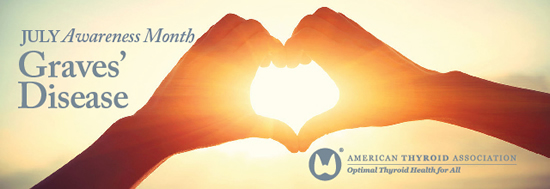
Clinical Thyroidology for the Public summarizes selected research studies discussed in the previous month’s issue of Clinical Thyroidology, an official publication of the American Thyroid Association. Editor-in-chief, Alan Farwell, MD, FACE
Volume 18 Issue 7
Available in pdf format for saving and printing and Web page format for viewing online
PDF Format for Saving and Printing
Clinical Thyroidology for the Public Volume 18 Issue 7 (PDF file, 3.32 MB)
TABLE OF CONTENTS – Web Format
GRAVES’ DISEASE
Hyperthyroidism treatment and thyroid eye disease
Some patients with Graves’ disease develop thyroid eye disease, a condition that causes inflammation of the eye and eye muscles. Treatment of TED depends on severity and can include high doses of glucocorticoids. This study examines the effects of the treatment choice for Graves’ disease affected moderate to severe TED and the response of TED to glucocorticoid treatment.
Cosentino G, et al. Ablative versus conservative approach for hyperthyroidism treatment in patients with Graves’ orbitopathy: a retrospective cohort study. Thyroid. 2025;35(3):298-306; doi: 10.1089/thy.2024.0633. PMID: 39909466
GRAVES’ DISEASE
Can statin drugs prevent thyroid eye disease?
Thyroid eye disease (TED) is caused by inflammation in the eye muscles in patients with Graves’ disease and can result in significant problems with vision that can be hard to treat. Recently, statin use has been associated with lower rates of TED in patients with Graves’ disease. The researchers of this study used a large patient database to determine the relationship between stating use and TED.
Chou YT et al. Statin use and the risk of Graves’ orbitopathy: a nationwide population-based cohort study. Thyroid 2025;35(2):199-207; doi: 10.1089/thy.2024.0536. PMID: 39804287.
THYROID CANCER
Why do thyroid cancer outcomes differ across racial and ethnic lines?
Past studies have shown that Black and Hispanic patients often have worse results during thyroid cancer treatment. The researchers wanted to better understand why thyroid cancer outcomes differ across racial and ethnic groups. They measured how much cancer type, treatment differences, and social factors contributed to these differences. They also examined whether the type of surgery patients received affected their chances of doing well.
Fwelo P et al. Disparities in thyroid cancer mortality across racial and ethnic groups: assessing the impact of socioeconomic, clinicopathologic, and treatment variations. Ann Surg Oncol 2025;32(2):1158-1175; doi: 10.1245/ s10434-024-16569-y. PMID: 39614001.
THYROID CANCER
Is neck ultrasound required in follow-up of lowrisk thyroid cancer in children?
Children and adolescents with thyroid cancer usually have an excellent response to treatment. Although postoperative follow-up with neck ultrasound poses little physical risk, potential harm from overuse can occur because of detection of false-positive or unclear findings, which trigger further investigation, health care expenditures, and patient anxiety. Data on the use of neck ultrasound follow-up in children are particularly lacking. This study examined the risk of thyroid cancer recurrence in children and adolescents and the use of neck ultrasound to follow thyroid cancer low risk patients.
Rao S, et al. Utility of ultrasound surveillance for thyroid cancer in children. Thyroid 2025;35(4):406-414; doi: 10.1089/thy.2024.0624. PMID: 39888311.
THYROID NODULES
How often are thyroid nodules with indeterminate results and negative molecular testing actually cancer?
While most thyroid biopsies show that a nodule is benign (not cancerous), sometimes, the results are unclear (indeterminate). If genetic tests on the cells removed during a biopsy are negative, these nodules are then considered benign. This study looked at how often these indeterminate nodules with negative results on genetic tests are benign and how many actually turn out to be cancer. They also looked at how best to follow these nodules over time.
Nachum S, et al. Thyroid nodules with indeterminate cytology and negative molecular profile: prevalence of malignancy and practice paradigms for surveillance. Thyroid 2025;35(3):265- 273; doi: 10.1089/thy.2024.0455. PMID: 39874551.
THYROID CANCER
Incidence and response to treatment for medullary thyroid cancer over time
Medullary thyroid cancer is a relatively uncommon but important form of thyroid cancer. The authors of this study used large European patient databases to evaluate changes in the incidence of medullary thyroid cancer over the last 30 years, as well as to study how surgical treatment for this cancer has changed during this time frame. In particular, these researchers focused on studying the impact changes in surgical treatment have had on the recurrence risk and survival for people diagnosed with medullary thyroid cancer.
Jager EC et al. Trends in the incidence, organization of care, and surgical treatment of medullary thyroid cancer: a population- based study. Thyroid 2025;35(1):87-96; doi: 10.1089/ thy.2024.0433. PMID: 39705074.



